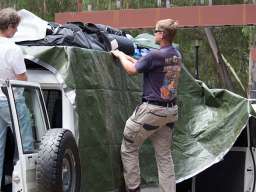ANU Archaeology students to unearth Tasmania's military and convict past

The Triabunna Barracks, Tasmania. Photo supplied by the School of Archaeology and Anthropology.
The ANU School of Archaeology and Anthropology's Triabunna Field School kicks off today with an expedition to uncover part of Tasmania's military and convict past.
The archaeological team, led by Dr Ash Lenton and Dr Duncan Wright, will be conducting the first excavation of the site of the Triabunna Barracks, home to the 51st Regiment of Foot who oversaw a colony of convicts at the nearby Maria Island from 1844 to 1851.
"Few colonial sites provide this opportunity to examine their decline and eventual abandonment," Dr Lenton says.
“We’ll be locating the remains of several large 19th century buildings and it’s possible we’ll come across military paraphernalia and other artefacts that were part of daily life at the barracks.”
The remains of a number of 19th century buildings are on site, and the students and field school co-convenors will be examining these to understand the construction techniques used in the buildings.
“There has been a lot of study of Port Arthur, but smaller sites like this often slip through the gaps. These sites are just as significant, helping us understand the varied military and convict history of Tasmania,” Dr Duncan Wright says.
“It is exciting that so many convict era sites still survive in this area, giving a window on past lives.”
The Triabunna Field School will run for three weeks from today. While there, members of the school will be providing site tours to visitors.
Below: loading up the van in preparation for the drive to Tasmania.


